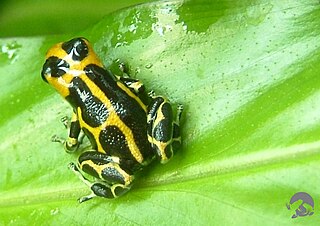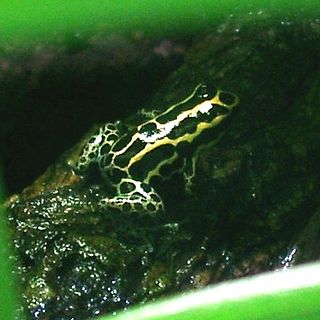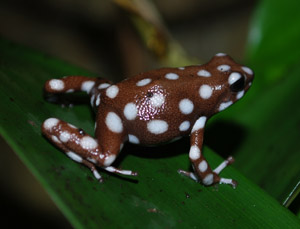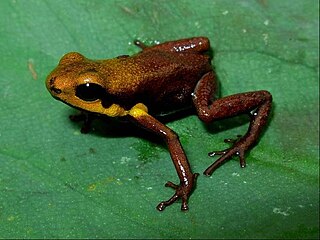
Epipedobates is a genus of poison dart frogs native to northern South America west of the Andes, including the western slopes. Common name phantasmal poison frogs has been suggested for the genus.

Ranitomeya imitator, is a species of poison dart frog found in the north-central region of eastern Peru. Its common names include mimic poison frog and poison arrow frog, and it is one of the best known dart frogs. It was discovered in the late 1980s by Rainer Schulte who later split it up into more subspecies; describing each as a specific color morph, and sometimes having a separate behavioral pattern. The acoustics, morphs, and behavior of the species have been extensively researched.

The Cauca poison frog is a species of frog in the family Dendrobatidae. It is endemic to Colombia.
Ranitomeya flavovittata is a species of frog in the family Dendrobatidae. It is endemic to Peru and known with certainty only from the Loreto Region where its type locality is.

The blue-bellied poison frog or bluebelly poison frog is a species of frog in the family Dendrobatidae.

The Andean poison frog is a species of frog in the family Dendrobatidae. It is endemic to Colombia. Its natural habitat is subtropical or tropical moist montane forests. It is threatened by habitat loss.
Ranitomeya rubrocephala is a species of frog of doubtful taxonomic status in the family Dendrobatidae.

Ranitomeya vanzolinii, also known as the Brazilian poison frog or spotted poison frog, is a species of frog from the family Dendrobatidae. It is found in the Amazonian rainforests of Brazil and Peru, and possibly Bolivia.

Andinobates virolinensis is a species of frog in the family Dendrobatidae. It is endemic to Colombia where it is confined to the Santander and Cundinamarca departments on the Cordillera Oriental.

Ameerega is a genus of poison dart frogs in the family Dendrobatidae. These frogs live around rocks that are nearby streams. They are found in central South America north to Panama. It contains many former species of the genus Epipedobates.

Ranitomeya is a genus of dart poison frogs found in Panama and South America south to Peru and Brazil, possibly into Bolivia.

Ranitomeya amazonica is a poison dart frog in the genus Ranitomeya. It was first described by Rainer Schulte in 1999 as Dendrobates amazonicus when he separated it from Dendrobates ventrimaculatus, primarily on the basis of call characteristics. The validity of the species has been debated, but further studies, also including genetic data, support its validity.

Ranitomeya variabilis, formerly known as Dendrodates variabilis, is a species of small poison dart frog distributed in northern Peru, along the eastern slope of Andes in the upper Rio Huallaga drainage basin. Its common name, Zimmerman’s poison frog, is named after Elke Zimmermann, a German zoologist who described the morph of this species and differentiated it from D. ventrimaculatus. The species was formerly considered to be synonymous with Ranitomeya ventrimaculata.

Dendrobatinae is the main subfamily of frogs in the family Dendrobatidae, the poison dart frogs of Central and South America, found from Nicaragua to the Amazon basin in Brazil.

Excidobates is a genus of poison dart frogs endemic to the Marañón River drainage in Peru and Ecuador, South America. At one time members of this genus were classified as Dendrobates. A characteristic of this genus is the presence of pale, ovoid spots on the under surface of the thighs.

Ranitomeya summersi, sometimes referred to as Summers' poison frog, is a species of poison dart frogs found in the central Huallaga River drainage and adjacent Cordillera Azul National Park in central Peru. Before 2008, the species was considered a subspecies of Ranitomeya fantastica. The IUCN considers it an endangered species because of limited habitat range, habitat loss, and collection for the pet trade.

Ranitomeya benedicta, sometimes called the blessed poison frog, is a species of poison dart frogs found in the lowland rainforest of the Pampas del Sacramento in southern Loreto and eastern San Martín Region, northeastern Peru. Before 2008, the species was considered a subspecies of Ranitomeya fantastica. The IUCN considers the species vulnerable because of limited habitat range, habitat loss, and collection for the pet trade.

Andinobates tolimensis, the Tolimense poison frog, is a species of amphibian in the family Dendrobatidae, endemic to Colombia in the outskirts of Falan and north of the department of Tolima. Previously it was included in the genus Ranitomeya, but was reclassified in Andinobates, along with 11 other species. It is threatened by habitat loss. It is toxic to humans and when captured will excrete a milky substance.

Andinobates geminisae is a species of poison-dart frog.

Andinobates cassidyhornae is a species of frog in the family Dendrobatidae found in Colombia in Antioquia in an altitude of 1800–2059 m.




























